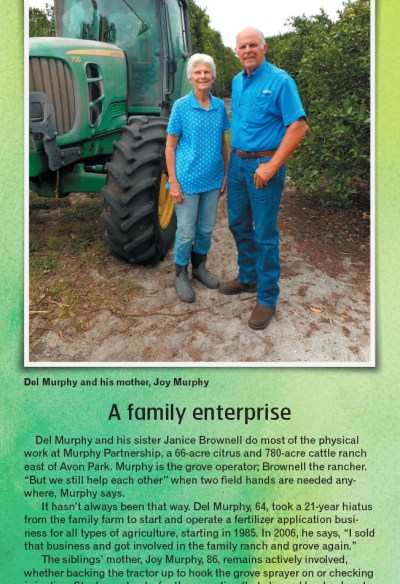
By Ernie Neff
It’s common belief — and probably true — that small Florida citrus growers have suffered more than larger growers as a result of HLB.
Del Murphy might agree, but his family’s 66-acre citrus grove east of Avon Park is doing well by any Florida standard. He says the Murphy Partnership production program seems to be working “as good as any in the industry.”
ORANGES VS. TANGERINES
Hamlins, accounting for 53 acres or 80 percent of the grove, reached peak production of 825 boxes per acre in the late 1990s and normally produced 600 to 700 boxes per acre pre-HLB. The disease knocked Hamlin production to a low of 290 boxes per acre in 2015–16 — not great, but not bad by HLB-era standards.
Hamlin production continued at approximately 290 boxes per acre for the next season. Even after Hurricane Irma knocked much fruit off the trees early in the 2017–18 season, Murphy picked 294 boxes of Hamlins per acre. In 2018–19, Hamlin production was 364 boxes per acre.
The grove’s 13-acre Valencia block yielded 324 boxes per acre last season. “It was a good year for Valencias,” Murphy says.
In the midst of all the good news for oranges is a horror story for Murphy’s Sunburst tangerines. A 13-acre block succumbed to HLB and was cleared in 2016. “In three years, it (the tangerine block) went from (returning) $64,000 to $13,000,” Murphy says. This March, he planted that 13 acres with Hamlins on US-942 rootstock. Murphy picked US-942 because “we’re trying to go with new research” showing it performs fairly well in the face of HLB.
PRODUCTION PRACTICES
“I think an important factor (for the good Hamlin production) has been Cleo rootstock,” Murphy says. Most of his Hamlins are on Cleo.
He also thinks bactericide, which he applied for 1.5 years before Hurricane Irma, contributed to the production bounce of recent years. “I feel like it was very important for us, and I am still applying it,” he says.
Murphy cites better irrigation practices, “where we’re putting the right amount on,” as another contributor to good production. He expresses gratitude for a Florida Department of Agriculture and Consumer Services’ (FDACS) cost-share program that paid the lion’s share of a soil moisture monitoring station with two sensors he placed in the grove. “It has cut my irrigation back, and I know in real time where the moisture is in my soil profile” by checking a computer screen, he says. The FDACS cost-share program has also helped him purchase other grove equipment.
Another production practice Murphy has implemented is injecting a sulfuric acid product to lower irrigation water pH. “It’s a given that that has helped,” he says.
The grove has been receiving compost applications for the past two years. Murphy says the compost improves water retention, increases organic matter in the soil and increases microbial activity.

NUTRITION MANAGEMENT
For the past eight years, Murphy has performed a leaf analysis every January and July “to see exactly what our practices have been doing in the trees. We’re able to see if we have (nutrient) deficiencies and then adjust accordingly.”
Changes in nutrition management play a major part in coping with HLB, says Murphy, who previously owned a commercial fertilizer application company (see “A family enterprise” sidebar).
“Because I have the fertilizer spreader, between February and June we make five dry applications 30 days apart,” says Murphy. “And then we’ll also inject liquid fertilizer between those dry applications.”
In the fall, the grove gets one or two dry fertilizer applications rotated between one or two liquid fertilizer applications applied through a microsprinkler system. All fertilizer applications are usually halted by Oct. 15. Murphy also has been adding a foliar product to increase the phosphate level in trees.
WHAT ELSE HAS HELPED
Murphy says the smallness of his operation helps him get good spray coverage. He sprays at 1.5 miles per hour, applying 167 gallons per acre “to get adequate coverage on my large trees,” he says. “In our grove, I think it makes a difference, and because of our small size we can do that.” He says it would be difficult for large growers to have sprayers move that slowly and still complete spraying in a timely fashion.
Finally, Murphy praises fellow Florida growers for their willingness to share useful production information, and gives special credit to one. “Marty McKenna has been our citrus consultant for over 15 years and has been a great guiding force through the HLB era,” he says.










